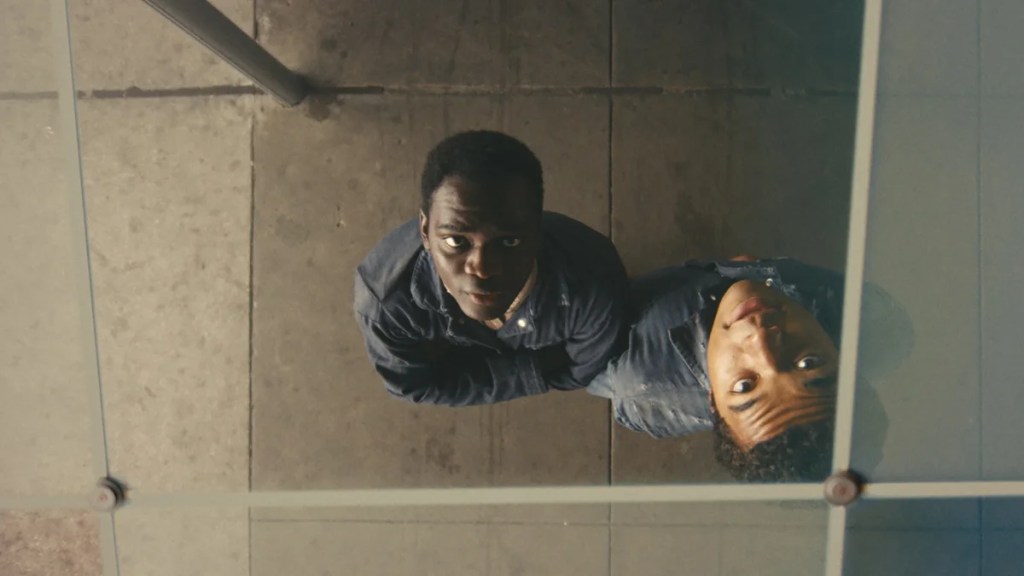Jomo Fray can pinpoint the day when the bold idea of “first-person perspective” truly clicked.
The Brooklyn-based cinematographer and his director, RaMell Ross (an Oscar nominee for the 2018 documentary “Hale County This Morning, This Evening”), had spent months discussing, studying, and experimenting for the filming of “Nickel Boys.” Based on Colson Whitehead’s novel, the movie is shot almost entirely through the eyes of its main characters, Elwood and Turner (played by Ethan Herisse and Brandon Wilson), two young Black men at an inhumane reform school in Florida.
The eureka moment came during a scene when Elwood’s grandmother (Aunjanue Ellis-Taylor) visits the school to deliver bad news to her grandson. “I was the camera operator for that scene,” said Fray. “And as she was building up the courage to tell Elwood something devastating, I looked away. I find it very difficult to look a person in the eyes when I know they’re telling me something that’s difficult for them. So my gaze floated away, and then, off script, Aunjanue put her hand out and said, ‘Elwood, look at me, son.’”
When filming stopped, Fray and Ross ran to the nearest monitor to see how it played.
The camera, as the character Elwood, operated by Fray, had been forced to meet his grandmother’s eyes. “Even though we had meticulously planned everything, this was an explosive moment for us in terms of realizing just how much fertile ground was within this camera language,” said Fray. “Because the camera isn’t just inside the scene – the camera actually responds to its scene partners, and that creates an intimacy and urgency in every shot.”
“Nickel Boys” is not the first film to place the audience in a first-person point of view. Fray and Ross watched Robert Montgomery’s “Lady in the Lake,” a 1947 noir that attempted the technique (with mixed results), but most of their artistic influences drew from recent movies with an innate humanistic vibe: “The Tree of Life,” “Son of Saul,” “Ida,” “Hard to Be a God.”
“We weren’t thinking about how to make a first-person film,” said Fray. “The big question was about how to create an image that feels always tied to a human body. We called it a sentient perspective – an image that feels like it’s attached to a real person.”


Fray elaborated on the term and its uniqueness as a storytelling vessel.
“The image is meant to be immersive, first and foremost,” he said. “But it’s also an invitation to those who are not used to being in these bodies. As an audience member, you live concurrently with Elwood and Turner. You quite literally see the world as they see it. What would it be like for you, walking down the road in the Jim Crow South, as you pass a white couple on the sidewalk? Where would your eyes go? The wrong glance could mean life or death for you. Or conversely, how wonderful would it feel to be taking pictures in a photo booth with your first girlfriend? How would those two opposite feelings sit in your body?”



On the film’s Louisiana set, Fray and his department employed several modular
systems to achieve the POV effect, including chest rigs on the actors. Through
experimentation, the filmmakers determined that a handheld camera mimicked the bodily feeling better than Steadicam. For scenes where Fray operated the camera, like Elwood’s meeting with his grandmother, he would watch and listen closely as Ross rehearsed with the actors.
“Ethan or Brandon would be incredibly close to my body so that I could be holding the camera, and they could have their hands or legs in the shot,” he said. “We also had backup costumes that I could wear, so the camera could look down and see my body as them.”


“Nickel Boys” premiered at fall film festivals to universal acclaim from critics and
audiences – or mostly universal acclaim, we should say. “There are definitely people who find it difficult to switch the way that they watch a movie,” Fray said with a smile. “But I’ve met so many who have embraced the experience. It’s been profound. Oftentimes, audience members have given me a hug and told me a personal story that might have nothing to do with the movie, but has to do with their childhood or growing up. It stirred an emotion for them and a memory.”
Visibly moved by his experience on the film, Fray added, “That’s the fundamental
promise of cinema: compassion. Whether it’s sci-fi, a period piece or present time,
movies let us walk a mile in someone else’s shoes. I love movies so much because they allow us to have a brief moment to think about what it feels like to be another person, to experience another human life, throughout this process of living.”
This story first appeared in the Below-the-Line Issue of TheWrap’s awards magazine. Read more from the issue here.



